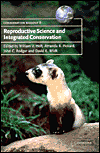

 |

|

The average rating for Reproductive science and integrated conservation based on 2 reviews is 3.5 stars.
Review # 1 was written on 2017-02-12 00:00:00 Mariko Gjovig Mariko GjovigUntil I read this book, Humphrey Carpenter's Inklings: C.S. Lewis, J.R.R. Tolkien, Charles Williams and Their Friends, published nearly thirty years ago, was the most comprehensive treatment of the group that I had ever encountered. It wasn't all that comprehensive, being focused mainly on C.S. Lewis as the central figure. Though the book was an engaging read, Carpenter tended to summarize and judge the Inklings' subsidiary writings for the reader, skipping mention of others altogether. Carpenter's main thesis appeared to be that these extremely intelligent, highly idiosyncratic scholars and writers had little influence on one another; as proof he quoted from some of their letters, reported statements, and even essays in which they made similar claims. Yet in the middle of the book he gives us a fictionalized chapter of a "typical" Inklings meeting, in which it's clear that they did indeed participate in a lively and vigorous way in following one another's work. Perhaps the sticking point was the word "influence" -- as if a writer's work is somehow diminished if he or she is not perceived to have completed creative work in total isolation. Beginning with the conviction, as Diana Pavlac Glyer says, "That each author's work is embedded in the work of others, and each author's life is intertwined with the lives of others," she proceeds, without the slightest hint of poisonous academic innuendo, to thoroughly dismantle Carpenter's argument. The level of scholarship in this book is the first thing that impressed me. Glyer has read everything by, and about, the Inklings. Not just that, she's up on the latest thinking about the process of writing and collaboration -- not just from a literary view, but from a psychological and sociological perspective. The authorities upon which she draws range from Harold Bloom's hothouse-fervid The Anxiety of Influence to Karen Burke LeFevre's Invention as a Social Act. Against this wider discussion of the process of creation, specifically how writers interact with other writers, whether in formal groups or informally, Glyer gives us a careful picture of the Inklings' history as a group, then breaks out for discussion of each member. As one would expect, she pays the closest attention to Tolkien and Lewis, but each gets a considered look at his place in the Inklings, and his work overall. She then focuses on the Inklings within the context of LeFevre's four roles of writers in interaction: as resonators, opponents, editors, and collaborators. Each chapter is followed by superlative notes. I learned things about the Inklings that I had never known in forty years of familiarity with them, for example the playful mock-legal battle that Owen Barfield and C.S. Lewis wrote and published (126 copies!) called "Mark vs. Tristram." This sparked by the academic firestorm caused by the appearance of Eugene Vinaver's three volume The Works of Sir Thomas Malory, specifically the debates about whether or not Malory's rather unsavory biographical details besmirched his stories about valor and virtue. Glyer's well-chosen quotes bring these men alive. One gains a sense of their mutual appreciation, the agreeable vigor of their debate, the passion they brought to the subjects they loved -- and the glee they took in spoofing one another, as well as literary and philosophical shibboleths of the day. She not only discusses well-known works, and critiques thereof, but describes projects abandoned, both collaborative and single. Given the level of scholarship here, the second impressive thing about this book is the clarity and charm of the prose. A young scholar new to the Inklings' work could enjoy this book and follow the arguments with as much enthusiasm as those of us long acquainted with the writers. It would have been so easy to produce an impenetrable tome, given the vastness of the research -- works cited alone requires twenty pages of tiny print. But Glyer achieves that rarity: an academically rigorous work that is fun to read. And that brings me to the third impressive thing, which is the supporting material. Each chapter contains full notes at the end, every single one shedding extra light on the referenced text or interchange. Then there is a superb Appendix, beginning with "The Inklings: Their Lives and Works," by David Bratman, the aforementioned "Works Cited," and an Index that serves as a model of precision and lucidity. This book is a must for libraries, and for anyone interested in the Inklings and their works. |
Review # 2 was written on 2016-10-14 00:00:00 Chase Fenn Chase FennIt is a wonderfully thought provoking book. Easy to read, very clear writing, and incredibly well referenced. The extensive footnotes at the end of each chapter were just as rewarding as the chapter itself. The book is a study of literary influence, using the Inklings as a case study. There has (evidentially) been a great deal of denial over the mutual influence of the Inklings on any particular member's particular work. First, the author goes through the four previously defined types of literary influence (Someone else's seminal work defined these 4 types, our author uses that as a frame, and then adds a fifth type) and shows how the Inklings provided that particular role for each other; second, she puzzles out why literary influence should be such an inflammatory topic. Following that is an appendix giving a brief biographical sketch of each Inkling, and even the Appendix is excellent. It was clear, well organized, well written, thought provoking, extraordinarily well referenced .. my only complaint is that her second section was so short. For anyone fascinated by literary influence theory or Inkling studies. I'll be re-reading this book. |
CAN'T FIND WHAT YOU'RE LOOKING FOR? CLICK HERE!!!